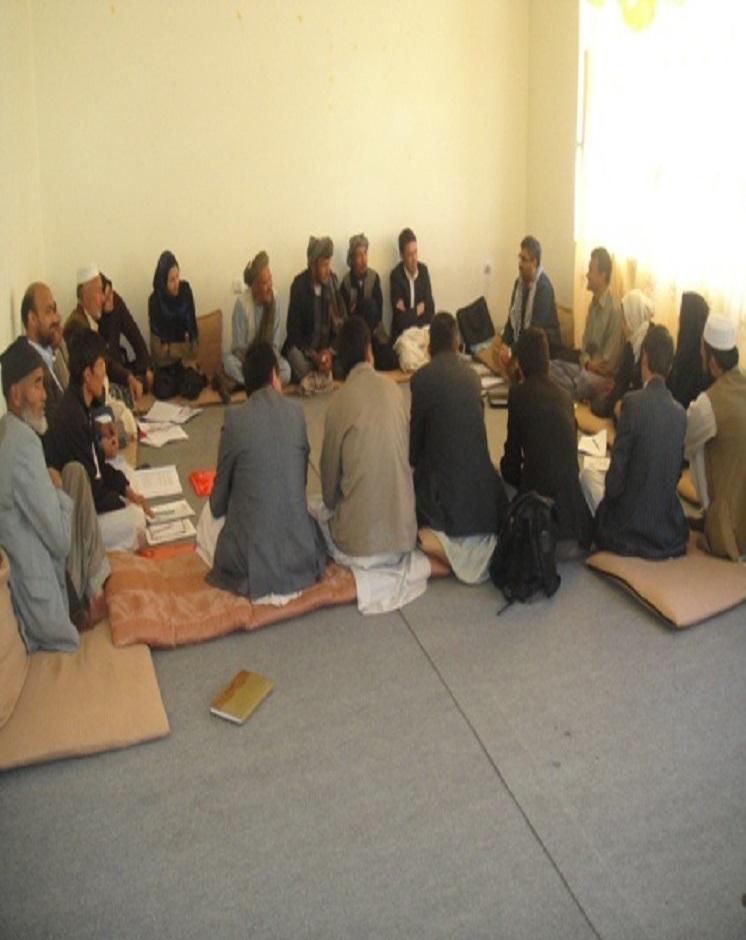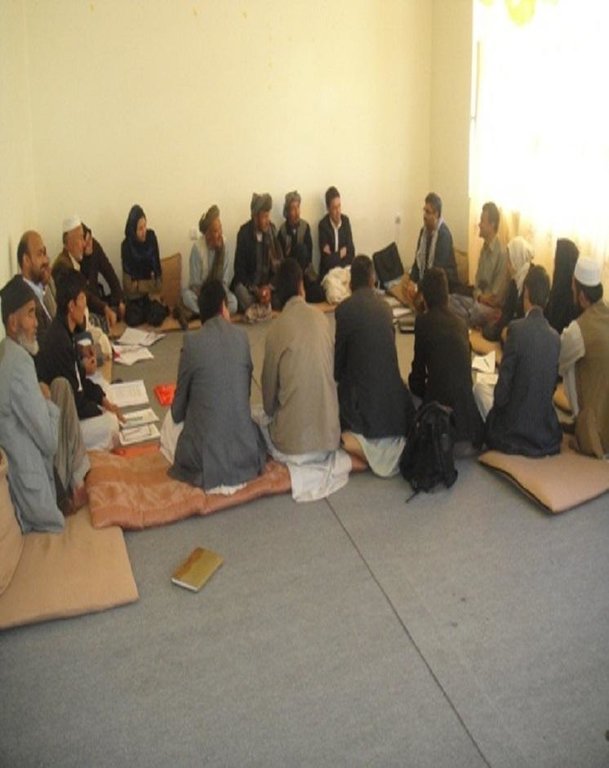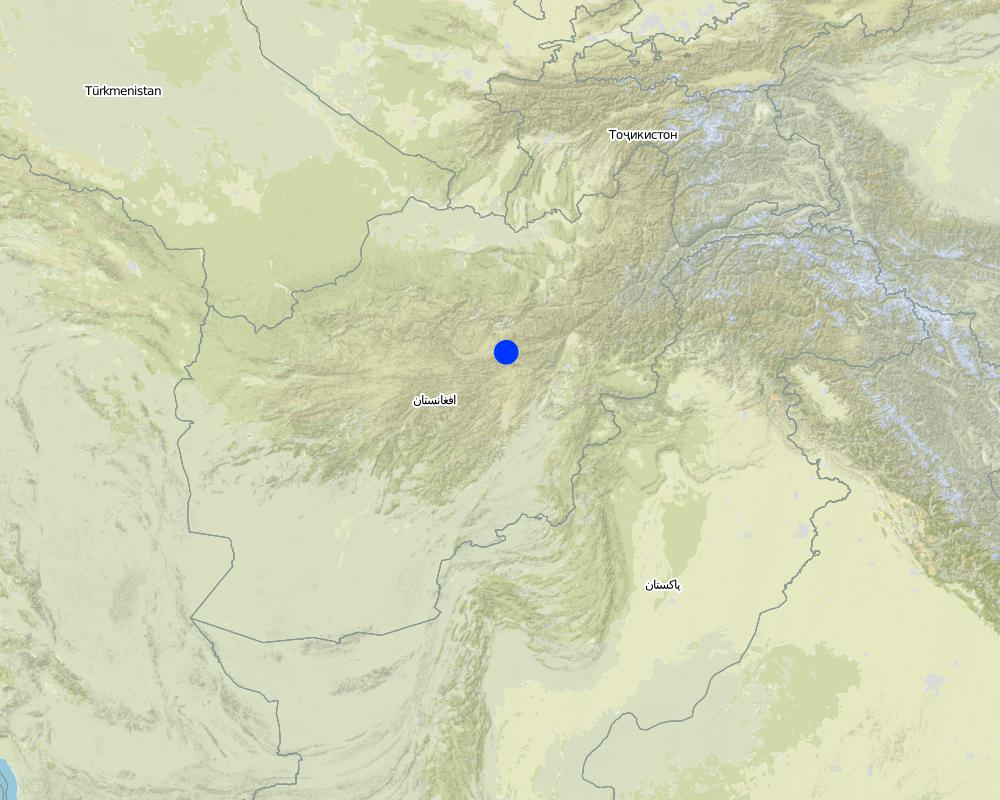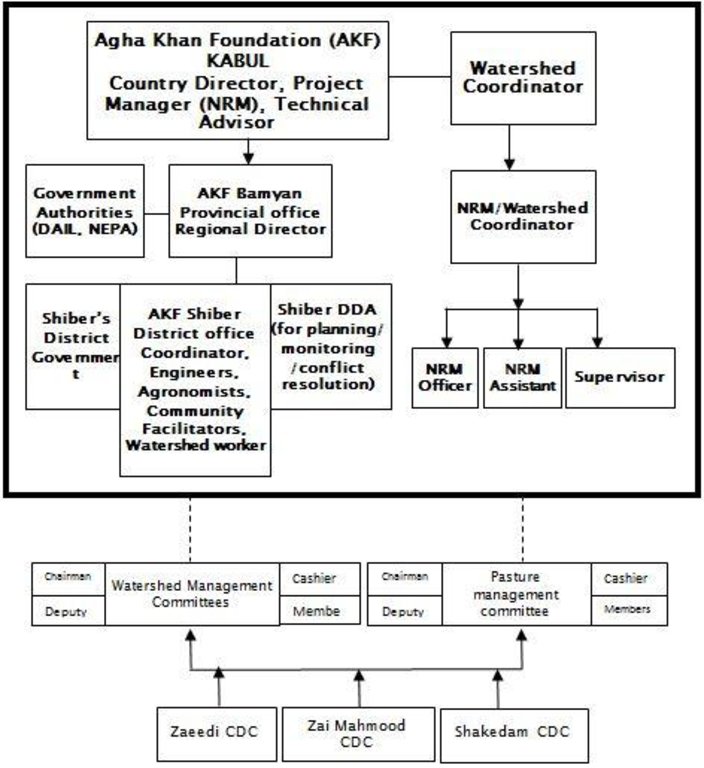Community-based Natural Resource Management [Афганистан]
- Создание:
- Обновить:
- Составитель: Aqila Haidery
- Редактор: –
- Рецензенты: Deborah Niggli, Joana Eichenberger
Tanzeem Manabae Tabiee Tawasut Mardum (Dari)
approaches_2542 - Афганистан
Просмотреть разделы
Развернуть все Свернуть все1. Общая информация
1.2 Контактные данные специалистов и организаций, участвующих в описании и оценке Подхода
Специалист по УЗП:
Специалист по УЗП:
Специалист по УЗП:
Ahmadi Ghulam Sakhi
AKF
Афганистан
Специалист по УЗП:
Jalil M. Altaf
AKF
Афганистан
Специалист по УЗП:
Hussaini Marzia
Афганистан
Специалист по УЗП:
Hussaini Baqir
Афганистан
Специалист по УЗП:
Wafa Jawad
Афганистан
Специалист по УЗП:
Jawadi Asadullah
Афганистан
Специалист по УЗП:
Yagoo Alex
Афганистан
Специалист по УЗП:
Eqbal Muhammad
Афганистан
Название организации (-ий), содействовавших документированию/оценке Подхода (если применимо)
HELVETAS (Swiss Intercooperation)1.3 Условия, регламентирующие использование собранных ВОКАТ данных
Когда были собраны данные (на местах)?
25/08/2015
Составитель и ответственный/-ые специалист(-ы) согласны с условиями, регламентирующими использование собранных ВОКАТ данных:
Да
1.4 Ссылка (-и) на Анкету (-ы) по Технологиям УЗП
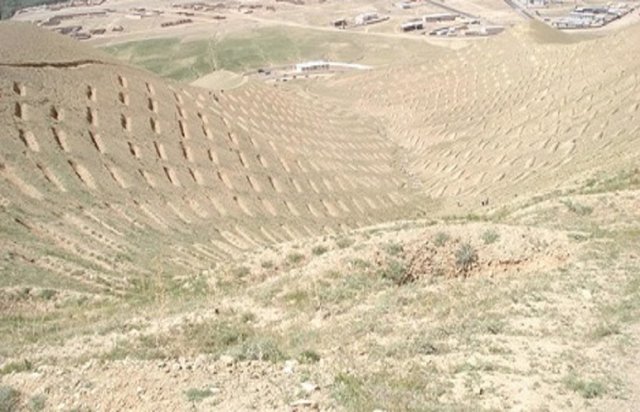
Staggered Contour Trench [Афганистан]
Earthen trenches with soil bunds built along contours in staggered design
- Составитель: Aqila Haidery
2. Описание Подхода УЗП
2.1 Краткое описание Подхода
An approach to community participation in the sustainable management of natural resources
2.2 Подробное описание Подхода
Подробное описание Подхода:
The main objective of the intervention was to reduce the surface run-off and sediment flow from the selected degraded watershed, with soil and water conservation measures through community participation.
Agha Khan Foundation and representatives from the selected Community Development Councils (CDC) surveyed the area and discussed the main land use problems. On the basis of feasibility surveys, potential SLM technologies were identified and implemented. Contour lines were prepared with the help of an A-frame and lime. Several men from Zai Mahmood village were employed as daily wage workers for the technology implementation works. The land users used their own tools for trench excavation. Each worker excavated on an average one trench per day. The daily wage was 250 AFS/USD.
The project was executed over two years. In addition to the structural measures, training and exposure visits for watershed management committee and pasture committee members, reseeding of more areas, tree plantation campaigns and group-based women vegetable farming were realized. Women were employed for seed collection work with cash for work approach. The area was protected from grazing and shrub cutting pressure. Seeds of different fodder varieties and shrubs were also cultivated.
Since the realization of the project in 2008, soil and vegetation cover has improved, people’s knowledge about soil and water conservation has increased, flash floods have been controlled and discharge in the spring located below the watershed has increased by about 40%. AKF continues to support the target communities with community development and institution building. The water-shed work is sustained by a watershed and pasture management committee appointed by the people from three respective CDCs.
The Community-Based Natural Resource Management approach is documented by Sustainable Land Management Project implemented/HELVETAS Swiss Intercooperation which is funded by Swiss Agency for Development and Cooperation with close support and cooperation of the Agha Khan Foundation (AKF).
The watershed project was funded by AusAID. The Aga Khan Foundation (AKF) facilitated the implementation by the community. The project was implemented in Zai Mahmood mountain slope area in Zai Mahmood village, Shiber district, Bamyan Province. The village, located downstream from the site, experienced problems such as excessive surface runoff/flash floods, snow avalanches, soil erosion, lack of drinking water, lack of soil moisture at the site.
2.3 Фотографии, иллюстрирующие Подход
2.5 Страна/ регион/ место, где применялся Подход
Страна:
Афганистан
Административная единица (Район/Область):
Zai Mahmood village
Более точная привязка места:
Bamyan center, Afghanistan
Map
×2.6 Даты начала и окончания реализации Подхода
Год начала реализации:
2008
2.7 Тип Подхода
- в рамках проекта/ программы
2.8 Каковы цели/ задачи Подхода
The Approach focused mainly on SLM with other activities (Disaster Risk Reduction, Pasture Improvement, Gender Equity, Income Generation)
Strengthen the capacity (organizational and technical), of the community to: restore their degraded lands, demonstrate multi-purpose soil and water conservation measures, reduce floods and snow avalanches, improve pastures, improve gender equity and the involvement of social disadvantaged groups, employment and income generation
The SLM Approach addressed the following problems: Lack of knowledge in terms of sustainable watershed management; poverty; drought; floods and avalanches
2.9 Условия содействующие применению Технологии/ Технологий в рамках Подхода или затрудняющие его
Социальные/ культурные/ религиозные нормы и ценности
- затрудняют
Community-based management capacity was weak
Treatment through the SLM Approach: CDCs capacities were enhanced
Наличие/ доступность финансовых ресурсов и услуг
- затрудняют
Community’s low economy
Treatment through the SLM Approach: AKF provided financial support; also there were contributions from the participating community
Институциональные условия
- затрудняют
Lack of organizational structures
Treatment through the SLM Approach: Watershed and pasture management committees formed
Осведомленность в области УЗП, доступность технической поддержки
- затрудняют
Lack of technical awareness
Treatment through the SLM Approach: AKF provided technical support
3. Участие и распределение ролей заинтересованных сторон
3.1 Заинтересованные стороны, участвующие в реализации Подхода и их роли
- местные землепользователи/ местные сообщества
- организации местных сообществ
3.2 Участие местных землепользователей/ местных сообществ на разных стадиях реализации Подхода
| Участие местных землепользователей/ местных сообществ | Перечислите участников и опишите их вовлеченность | |
|---|---|---|
| инициирование/ мотивация | интерактивное | Meetings and Workshops for men and women |
| планирование | интерактивное | With CDC members, mainly men for watershed works |
| выполнение | внешняя поддержка | Interactive, Cash for work, Contributions from communities as well |
| мониторинг/ оценка | интерактивное | Ad hoc observations |
| Research | интерактивное | Analyzing technology performance and making adjustments if required |
3.3 Схема реализации (если имеется)
Описание:
The organization structure of the NRM project implemented in Zai Mahmood village, Shiber district, Bamyan, Afganistan
Автор:
Agha Khan Foundation (AKF)
3.4 Принятие решений по выбору Технологии/ Технологий УЗП
Укажите, кто принимал решение по выбору применяемой Технологии/ Технологий:
- преимущественно специалисты по УЗП после консультаций с землепользователями
Поясните:
AKF conducted awareness workshops before project implementation.
Decisions on the method of implementing the SLM Technology were made by mainly by land users supported by SLM specialists. land users implemented the technology after receiving guidelines from SLM specialists.
4. Техническая поддержка, повышение компетенций и управление знаниями
4.1 Повышение компетенций/ обучение
Проводилось ли обучение землепользователей/ других заинтересованных лиц?
Да
Укажите, кто проходил обучение:
- землепользователи
- местный персонал/консультанты
Тип обучения:
- в ходе работы
- обмен опытом между фермерами
- опытные участки
- общие собрания
Рассматриваемые темы:
Vegetable farming for women; soil and water conservation; watershed management; pasture management. Training was mainly on-the-job, and awareness was raised through public meetings, site visits and demonstrations.
4.2 Консультационные услуги
Есть ли у землепользователей возможность получать консультации?
Да
Описание/ комментарий:
On-site visits by DAIL (Department of Agriculture, Irrigation and Livestock; Key elements: Pasture management, Site selection
Advisory service is quite adequate to ensure the continuation of land conservation activities; The government or other advisory service is quite adequate to ensure the continuation of land conservation activities although the staff turnover rate in government sector is high. DAIL Bamyan office has the technical capacity but not adequate financial resources.
4.3 Институциональная (организационная) поддержка
В ходе реализации Подхода были ли организованы новые институциональные структуры или поддержаны уже существующие?
- да, существенно
Укажите уровень, на котором структуры были укреплены или вновь созданы:
- местные
Укажите тип поддержки:
- финансовая
- повышение компетенций/ обучение
Подробнее:
CDCs and District Development Assembly (DDA) in terms of financial and capacity building of participating
4.4 Мониторинг и оценка
Являются ли мониторинг и оценка частью Подхода?
Да
Комментарии:
bio-physical aspects were regular monitored by project staff, land users through measurements; indicators: Biomass before and after
technical aspects were ad hoc monitored by project staff, land users through observations; indicators: growth of saplings, shrubs and fodder grasses (alfalfa)
socio-cultural aspects were ad hoc monitored by project staff, land users through measurements; indicators: Water availablity, food security, income
economic / production aspects were regular monitored by project staff through measurements; indicators: fodder production, income
area treated aspects were ad hoc monitored by project staff through measurements; indicators: areas where technology was applied
no. of land users involved aspects were regular monitored by project staff, land users through measurements; indicators: CDCs and men and women involved
management of Approach aspects were regular monitored by project staff, government, land users through observations; indicators: area protected or not
There were few changes in the Approach as a result of monitoring and evaluation: Women has given some more chances for the participation but still there is long way to go. There were some technology refinements and adjustments in project management.
4.5 Научные исследования
Были ли научные исследования частью Подхода?
Да
Укажите темы исследований:
- социология
- экономика / маркетинг
- экология
- технология
Напишите подробнее и назовите тех, кто выполнял исследования:
However there are no publications to verify that. Research was carried out on-farm
5. Финансирование и внешняя материальная поддержка
5.1 Годовой бюджет мероприятий по УЗП в рамках Подхода
Если точный годовой бюжет неизвестен, укажите примерный диапазон затрат:
- 10000-100000
Комментарий (например, основные источники финансирования/ ключевые доноры):
Approach costs were met by the following donors: international: 50.0%; national non-government: 30.0%; local community / land user(s): 20.0%
5.4 Кредитование
Предоставлялись ли в рамках Подхода кредиты на мероприятия УЗП?
Нет
5.5 Другие методы или инструменты стимулирования
Использовались ли другие методы или инструменты стимулирования для продвижения Технологий УЗП?
Нет
6. Анализ влияния и заключительные положения
6.1 Влияние Подхода
Сумел ли Подход помочь землепользователям внедрить и поддерживать технологии УЗП?
- Нет
- Да, немного
- Да, умеренно
- Да, существенно
Increased water and soil quality with more vegetation and reduction in floods
Сумел ли Подход расширить возможности социально и экономически уязвимых групп?
- Нет
- Да, немного
- Да, умеренно
- Да, существенно
Through increased decision-making powers about natural resources by poor and marginalized members of the community.
Did other land users / projects adopt the Approach?
- Нет
- Да, немного
- Да, умеренно
- Да, существенно
There is no spontaneous adoption.
Did the Approach lead to improved livelihoods / human well-being?
- Нет
- Да, немного
- Да, умеренно
- Да, существенно
Cash for work improved income of some families, flash floods reduced, spring discharge increased, natural assets preserved.
Did the Approach help to alleviate poverty?
- Нет
- Да, немного
- Да, умеренно
- Да, существенно
By increasing water for agriculture and feed for livestock
6.2 Основные причины, побуждающие землепользователей внедрять УЗП
6.3 Долгосрочная устойчивость мероприятий в рамках Подхода
Могут ли землепользователи самостоятельно (без внешней поддержки) продолжать применение того, что было реализовано в рамках Подхода?
- нет уверенности
Если нет или нет уверенности, объясните почему:
Although the participating CDCs indicate that they will continue to manage the watershed properly
6.4 Сильные стороны/ преимущества Подхода
| Сильные стороны/ преимущества/ возможности по мнению составителя или других ключевых специалистов |
|---|
| Increase in vegetation cover |
| People knowledge regarding SWC improved |
| Increase in spring water |
| Flash flood controlled |
| Watershed and pasture management committees formed |
6.5 Слабые стороны/ недостатки Подхода и пути их преодоления
| Слабые стороны/ недостатки/ риски по мнению составителя или ответственных специалистов | Возможные пути их преодоления/снижения? |
|---|---|
|
Disturbance in NRM / soil disturbance |
Minimize the soil disturbance, and compact the excavated soil |
| Increase in mice | Compact the excavated soil, other control measures |
| Plant growth is slow due to high elevation | Choose adaptable species |
| No watershed benefit sharing mechanism in place | Benefit mechanism be developed in a participatory way and agreed by the land users and other stakeholders |
7. Справочные материалы и ссылки
7.1 Методы сбора/источники информации
- выезды на места, полевые обследования
- опросы землепользователей
Ссылки и модули
Развернуть все Свернуть всеСсылки

Staggered Contour Trench [Афганистан]
Earthen trenches with soil bunds built along contours in staggered design
- Составитель: Aqila Haidery
Модули
Нет модулей


